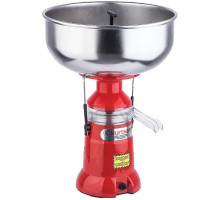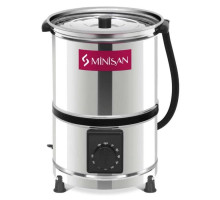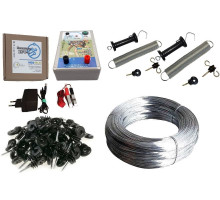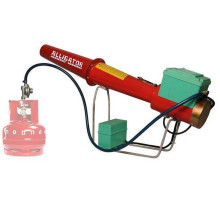Cattle owners know how important it is to ensure safe and efficient grazing for their animals. Traditional fences often require significant investment of time and resources for construction and maintenance. A modern, cost-effective and highly effective solution is an electric fence . This system allows you to control the movement of animals on the pasture, preventing their escape and protecting crops. But how to choose an electric fence for cows that will perfectly meet your needs? Let's understand all the nuances.
In this article, we will look at the key aspects of choosing, installing, and operating an electric fence so you can make an informed decision and ensure the comfort and safety of your animals.
What is an electric shepherd and why is it needed for cows?
An electric fence , or electric shepherd , is a system consisting of a power source (pulse generator), conductors (wire or tape), insulators, and grounding. The principle of its operation is to deliver short but noticeable electrical pulses through the conductors. When an animal touches the fence, it receives a harmless but unpleasant electric shock, which quickly forms a reflex in it to avoid contact with the fence.
For cows, an electric shepherd is an ideal solution for several reasons:
- Effective grazing control: Allows for effective grazing management in a specific area, preventing grass trampling and allowing it to recover quickly.
- Mobility: Unlike stationary fences, an electric fence is easily assembled, dismantled, and moved to new pastures, which is especially convenient for rotational grazing.
- Economic benefit: The price of an electric cow fence is usually much lower than the cost of building a permanent fence. In addition, it requires minimal maintenance.
- Animal safety: The electric impulse is short-lived and safe for the health of animals, but effectively discourages the desire to approach the fence.
- Predator protection: Can serve as an additional barrier to small predators trying to enter the pasture.
Key components of an electric shepherd: what is worth knowing?
To choose the right electric cowherd , it is important to understand the role of each component of the system.
Pulse generator (electrifier)
This is the “heart” of the system, converting electrical energy into high voltage pulses. When choosing a generator, pay attention to the following parameters:
- Power (pulse energy, Joules): This is one of the most important. The larger the pasture area, the longer the perimeter of the fence, and the denser the vegetation, the more powerful the generator is needed. For cattle, generators with pulse energy from 2 to 10 Joules or more are recommended.
- Output Voltage (Volts): Quality generators produce voltages ranging from 6,000 to 12,000 Volts. The high voltage provides effective penetration through the animal's fur.
- Power source:
- 220V Electric Shepherd: Connects to a fixed electrical network. Ideal for areas near buildings where there is access to electricity.
- Battery-powered electric shepherd (12V): The most common option for remote pastures. The battery requires periodic charging.
- Solar-powered electric shepherd: A self-contained system that charges the battery using a solar panel. Ideal for very remote areas without access to the power grid, but requires a larger initial investment.
- Hybrid models: Some generators can operate from multiple power sources (e.g. 220V and 12V).
- Fence Length (km): Manufacturers specify the maximum length of fence that a generator can effectively service. Always choose a generator with a power reserve.
Conductors
Different types of conductors are used for cattle electric fences :
- Wire: The most common and cheapest option. Can be galvanized or stainless steel. Galvanized wire 1.8-2.5 mm is good.
- Tape: Wide tape (12-40 mm) is more visible to animals, reducing the chance of accidental contact. Contains woven metal threads for conductivity. Recommended for horses, but can also be used for cows.
- Cord/Twine: Less visible than tape, but has better visibility than wire. Also contains conductive strands.
Choose a conductor with low resistance (Ohms/meter) to minimize energy loss over long runs.
Insulators
Insulators are attached to support poles and prevent current leakage into the ground. They come in different types:
- Ring insulators: The simplest and cheapest, suitable for straight sections.
- Corner insulators: Stronger, used at corners and for tensioning wire.
- Feedthrough insulators: For routing wire through holes in poles.
It is important that the insulators are of high quality and resistant to UV radiation and temperature changes.
Support pillars
They can be wooden, metal or plastic. Plastic posts with built-in insulators are very convenient for temporary fences. The distance between the posts depends on the terrain and the type of conductor, but on average it is 8-15 meters.
Grounding
Good grounding is critical to the effective operation of an electric shocker . It provides a complete electrical circuit when an animal touches the wire. Typically, this is a series of metal rods (ground rods) driven into the ground and connected to the generator. The drier the ground, the more ground rods may be needed.
How to choose an electric cowherd: a detailed guide
The process of selecting an electric cowherd kit requires taking into account several factors:
1. Size and type of pasture
- Fence Length: Measure the perimeter of the area you want to fence. This will determine the length of wire and generator power you need. Always use extra.
- Terrain: Hilly terrain or areas with dense vegetation require a more powerful generator to compensate for possible power losses.
- Soil type: Dry, sandy soils conduct current less well, requiring better grounding.
2. Number and type of animals
This article is about cows, but it is worth noting that different species of animals require different thicknesses and heights of fencing. For adult cows, 2-3 lines of wire at approximately 60 cm, 90 cm and 120 cm above the ground are recommended. For young cattle, an additional lower line at a height of 40-50 cm may be required.
3. Power source
Choose a power source based on your power availability and the mobility you need:
- For stationary fences near buildings - 220V electric fence .
- For remote or temporary pastures – a battery-powered electric shepherd or a solar-powered electric shepherd .
4. Budget
The price of an electric cowherd can vary greatly. Don't skimp on the generator and grounding, as these are key elements of the system. Quality insulators and conductors are also important for durability and efficiency.
Table: Recommended generator power depending on fence length and conditions
Installing an electric cowherd: basic rules
Proper installation of an electric cowherd is the key to its effective operation and safety.
- Marking the territory: Determine the exact perimeter of the fence and the locations of the support posts.
- Installing the posts: Drive or dig in the support posts at equal distances (8-15 m). Make sure they are firmly secured.
- Attaching insulators: At the required height (for cows 60-90-120 cm), attach the insulators to the posts.
- Tensioning the conductor: Carefully pull the wire or tape through the insulators. It is important to ensure proper tension, but not overtightening.
- Grounding: Drive metal rods (at least 1 meter deep) into the ground, preferably in a damp place. Connect them together and to the generator ground terminal using good quality wire.
- Connecting the generator: Connect the generator to the fence and to ground. Follow the manufacturer's instructions.
- Testing: After installation, be sure to test the system with a special voltage tester. The voltage at any section of the fence must be at least 3000 Volts.
Important: Always install warning signs about the electric fence around the perimeter!
Advantages and disadvantages of an electric cowherd
Although an electric cattle feeder has many advantages, it is worth considering possible disadvantages.
Advantages:
- Flexibility: It is easy to change the size and shape of the pasture.
- Low costs: Savings on materials and labor compared to capital fences.
- Quick installation: Installation takes significantly less time.
- Effectiveness: Quickly teaches animals to respect boundaries.
- Reduction of the human factor: The need for constant supervision of the herd is reduced.
Disadvantages:
- Dependence on electricity: In the event of a power outage (for 220V models) or battery discharge, the system stops working.
- Vegetation Sensitivity: Dense grass and bushes touching the wire can cause current leakage and reduce efficiency. Regular mowing is required.
- Maintenance: Requires periodic inspection of wire integrity, insulators, and battery charge level.
- Theft risk: Generators and batteries can be subject to theft in remote locations.
Electric Shepherd Care and Maintenance
To ensure the long-lasting and efficient operation of your electric cowherd , follow these recommendations:
- Regular voltage checks: Use a voltmeter to check the voltage at different points on the fence. This will help identify areas where current is leaking.
- Vegetation mowing: Regularly mow grass and remove bushes under the fence to avoid blockages and reduced efficiency.
- Grounding Check: Make sure the grounding rods are securely connected and in moist soil.
- Inspect conductors and insulators: Check the wire for breaks and the insulators for damage. Replace defective elements promptly.
- Charging the batteries: If you are using a battery-powered electric shepherd, check and charge the battery regularly.
- Lightning Protection: It is recommended to install lightning protection to protect the generator from damage during a thunderstorm.
If there are problems with the system (for example, animals breaking through the fence), the most common cause is poor grounding, a broken wire, damaged insulators, or insufficient generator power for the given fence length and conditions.
Norms and rules for using an electric shepherd in Ukraine
In Ukraine, the use of electric fences is regulated by certain norms and rules. Although there is no specific separate law that regulates each aspect in detail, it is worth following the general safety rules and civil legislation. The main recommendations are:
- Mandatory installation of warning signs: Signs with the inscription "Caution! Electric fence!" or an appropriate symbol must be placed in conspicuous places around the perimeter of the fence. This will protect third parties from accidental contact and potential injuries, and you from liability.
- Safe voltage and pulses: The pulse energy should be such that it causes only discomfort and not harm a person or animal. Standardization of electric fences provides for non-lethal pulses.
- Distance to roads and public places: Ensure sufficient distance from the electric fence to public roads and places of mass gathering to minimize the risk of accidental contact.
- Grounding: It is important to ensure good and safe grounding to avoid current leakage and the risk of shock.
- Intended use: The electric shepherd is intended for keeping animals, not as a means of protection against unauthorized access or harm.
Before installation, it is always a good idea to familiarize yourself with current recommendations and, if necessary, consult with specialists or local authorities regarding specific requirements for your area.
Conclusion
Choosing and installing an electric cowherd is an important decision that greatly facilitates pasture management and ensures animal safety. A properly selected electric cowherd kit , taking into account the generator power, conductor type, power source and high-quality grounding, will become a reliable assistant in your farm.
Remember to take regular care and maintenance to keep your system running efficiently for many years. By investing in a quality cattle feeder , you are investing in the productivity, safety and peace of mind of your farm.
We hope this detailed guide has helped you understand how to choose an electric cowherd , and you can make the best choice for your needs in Ukraine.













